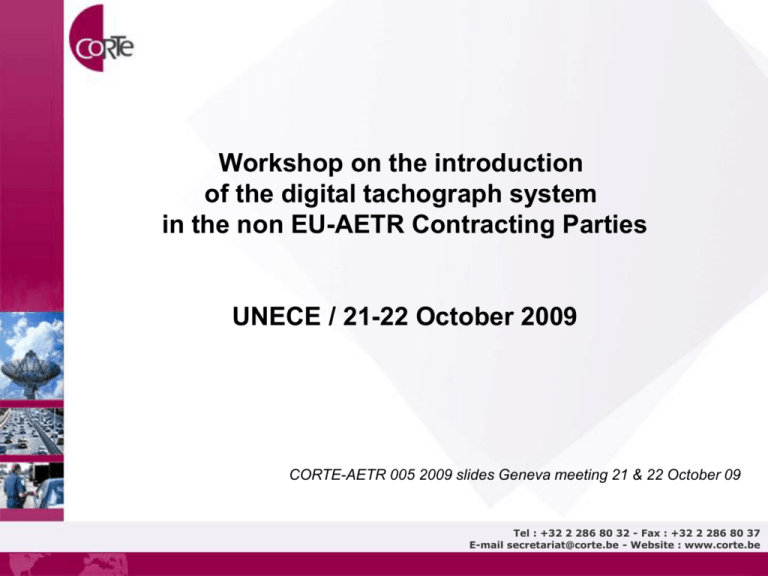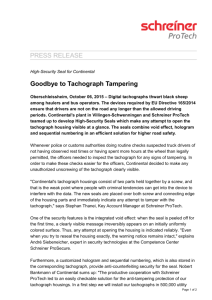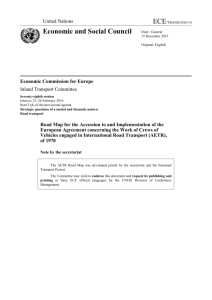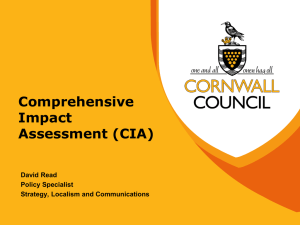Drivers' hours' rules - United Nations Economic Commission for
advertisement

Workshop on the introduction of the digital tachograph system in the non EU-AETR Contracting Parties UNECE / 21-22 October 2009 CORTE-AETR 005 2009 slides Geneva meeting 21 & 22 October 09 Tel : +32 2 286 80 32 - Fax : +32 2 286 80 37 E-mail secretariat@corte.be - Website : www.corte.be Brief presentation of CORTE 1. Genesis of CORTE Setting up of an informal group of experts (called for some years the “EU Enforcers Group) initiated by the EC – DG Tren in 1997 to deal with enforcement of commercial vehicles - From 1997 to 1999 : definition of control officers’ needs as far as digital tachograph was concerned - From 1999 to 2004 : analysis of the different ways of enforcing Drivers’ Hours Rules throughout Europe and proposals for amending the existing EU texts 2 – Setting up of CORTE In 2004, Member States’ enforcement authorities decided to transform their unofficial group of experts into an official one in order: - to develop more formal activities together with the EC, the UNECE (AETR) and national authorities - to enlarge their activities so that as to cover road safety issues as well An international association has been set up in April 2005 - with statutes and rules of order - a Board and a General Assembly - based in Brussels - submitted to Belgian law - expected at mid-term to gather all AETR enforcement authorities - opened to NGOs and industry Founding members: - Denmark : National Police - Ireland : Department of Transport - Sweden: Swedish Road Administration (SRA) - UK : Vehicle & Operator Service Agency (VOSA) 3 - Objectives • The development and agreement of common interpretations in the field of Road Transport Legislation and Enforcement. • To develop harmonised Best Practice enforcement methodologies 4 – Membership: 3 categories of members Full members: national enforcement authorities and/or regulatory bodies Associate members : NGOs Observers : Industry Full members: Belgium Bulgaria Cyprus Czech Republic Denmark Estonia Hungary Finland Greece Ireland Latvia Luxembourg Malta Romania Slovakia Slovenia Spain Sweden The Netherlands UK Bosnia and Herzegovina Croatia Georgia Iceland Moldova Montenegro Norway Serbia Turkey Ukraine 4 → 30 full members Full members: Objectives: Gather all EU and EEA Member States by the end of 2010 Extend to the AETR countries as soon as possible (by the end of 2011) Associate members ACEA → Vehicle manufacturers European Transport Safety Council (ETSC) → Road Safety European Transport Workers’ Federation (ETF) → Drivers’ Hours Enforcement Fédération Internationale Automobile (FIA) → Road users International Road Union (IRU) → Drivers’ Hours Enforcement ICTCT → Road Safety and Research Etc …………… Associate members: Objectives: associate all the major actors in the field of road traffic enforcement Observers: Actia Continental Efkon Stoneridge Electronics Semmler Gmbh PC Net Service Tachodisc Ltd Etc… More than 60 members in total CORTE has a consultative status in many EU official committees dealing with road safety, road transport enforcement, etc… CORTE has initiated a process at the UNO to become an official consultative body On the digital tachograph more specifically MIDT Platform www.eu-digitaltachograph.org Project management European Commission Secretariat Dedicated web site Dedicated Help desk Plenary CINC ENC IPC Birgit SÄÄV (S) Armand BIBERICH (L) Marja VAN DER WEL (NL) Hans DRIJER (NL) Frank DAVIDSEN (DK) Joaquin DEL MORAL (SP) Neil BARLOW (UK) Ingrid LUTNAES (NOR) Christina VELINOVA (BG) Thierry GRANTURCO Thierry GRANTURCO Thierry GRANTURCO WEB SITE Key elements: - Legislation - Type approval - Activation - Calibration - Equipment life cycle - Tachograph cards - Card issuing - Networking between CIAs - How to use the digital tachograph system - Data download - Data protection - Security WEB SITE State of play of the implementation of the digital tachograph in: - the EU Member States the EEA countries the non EU-EEA AETR Contracting Parties Points of contact: - in each country for each particular topic to be covered further information available on the private part of the web site (contact details of national experts) WEB SITE FAQ (most frequent asked questions) News (on the digital tachograph system) Links (to all main digital tachograph stakeholders concerned) Help desk HELP DESK From 2005 to 2009, an average of 1,120 questions were answered per month, which accounts for 56 questions per day. Questions submitted – by - since August 2005 to February 2009 41 094 45000 40000 35000 30000 25000 20000 15000 2 028 10000 5000 0 International ins titutions C ountries Countries: 41,094 International Institutions : 2,028 (50/month; 2,5/day) Total: 43,122 Questions submitted – by - since August 2005 35000 36,619 30000 25000 20000 15000 10000 6,503 5000 0 EU Countries Non EU/AETR Countries EU Countries: 36,619 (+/- 85%) Non EU/AETR Countries : 6,503 Total: 43,122 (100%) (+/- 15%) Questions submitted – by - since August 2005: National authorities: Manufacturers: Transport companies: Drivers: International institutions: 51 % 25 % 10 % 9% 5% Helpdes k ques tions s ubmitted s ince A ugus t 2005 International ins titutions 5% D rivers 9% T rans port c ompanies 10% Manufac turers 25% National authorities 51% Professional category Number of questions submitted by category TOTAL 43,122 National authorities 22,517 Manufacturers 10,643 Transport operators 4,233 Drivers 3,701 International institutions 2,028 Statistics per topic since August 2005: L egis lative is s ues 35,00% 30,80% 30,00% Tachograph/cards functionalities 27,86% E nforcement C ard Is s uing 25,00% 20,00% Works hops approval 18,32% S ecurity 15,00% 12,76% D ata protection 10,00% Type approval 5,01% 1,70% 1,49% 0,90%0,69% 0,47% 5,00% 0,00% 1 R is k management Ineligible Topics Number of questions submitted by topic TOTAL 43,122 Legislative issues 13,281 Tachograph/cards functionalities 12,013 Enforcement 7,900 Card Issuing 5,503 Workshops approval 2,161 Security 734 Data protection 642 Type approval 389 Risk management 297 Ineligible 202 The help desk is now restricted to: 1. the use of the English language 2. CORTE members Therefore: • the CORTE Secretariat is no longer answering questions from non-members • the number of questions answered has considerably decreased in 2009 Brief presentation of the speakers In chronological order: Thierry GRANTURCO – CORTE CEO Birgit SÄÄV – CORTE / Swedish Transport Agency Neil BARLOW – CORTE / VOSA (UK) Hans DRIJER – CORTE / Vehicle Inspectorates (NL) Agenda We will address: 1) The legal framework 2) Implementing the digital tachograph system: the logical steps to follow 3) Which support can the AETR countries benefit from? We will address: 1) The legal framework 2) Implementing the digital tachograph system: the logical steps to follow 3) Which support can the AETR countries benefit from? 1) The legal framework 1-1: EU rules and their evolution 1-2: AETR rules 1-3: Practicalities 1-4: Consequences of not meeting the AETR deadlines 1) The legal framework 1-1: EU rules and their evolution 1-2: AETR rules 1-3: Practicalities 1-4: Consequences of not meeting the AETR deadlines Considering the constant increase of: • registration of passenger cars • registration of commercial vehicles as a consequence of this, the constant increase of: • • • • road traffic congestion road traffic accidents fatalities and injuries the number of heavy vehicles involved in fatalities the EU legislator has decided in 1969 to regulate the professional drivers’ activities for the very first time. Regulation (EEC) n° 543/69, Official Journal L 77, page 49 (see http://europa.eu.int/eur-lex/lex/en/index.htm) This Regulation aimed mainly at: • limiting driving time allowed by day and by week • obliging professional drivers to record their activities through a recording equipment called “tachograph” or, alternatively, to use a kind of booklet First generation of recording equipment In the EU In the meantime, the EU signed in 1970 under the auspices of the United Nations an agreement called AETR extending the use of the recording equipment to the European but non EU Members (former Eastern countries, former Soviet republics, Balkan countries, etc…) For EU drivers, the use of recording equipment became mandatory including outside the EU whilst for non EU AETR drivers, the use of recording equipment became mandatory for international journeys only The AETR agreement foresees that each change of the recording equipment decided by the EU has to be implemented at AETR level so that each generation of recording equipment, as presented hereinafter, has also been the one used at AETR level This Regulation changed considerably the drivers’ behaviour But the recording equipment was not yet mandatory in the sense that booklets could be used instead Therefore, to avoid any distortion of competition between transport operators, the EU legislator decided to amend the 1969 Regulation in 1985 and to introduce a recording equipment on a mandatorily basis for every professional driver Except for very few exceptions Regulation (EEC) n° 3821/85, Official Journal L 370, page 8 See http://eur-lex.europa.eu/LexUriServ/LexUriServ.do?uri=CONSLEG:1985R3821:20070411:EN:PDF This new Regulation: • was much more demanding with drivers (in terms of driving, working, availability and rest times) • increased the number of data collected by the tachograph through the charts used to record data (speed, time, distances, names of drivers/ co-drivers, locations, vehicle registration numbers, etc… have to be recorded and stored) • introduced new obligations for transport operators (in terms of breakdown or faulty operation of their tachograph) • introduced more stringent requirements for the repair workshops to ensure a proper calibration of these recording equipments Over the time, the recording equipment evolved and from mechanical became electronic First generation Second generation But both generations are anyway working with paper discs Nevertheless, it became rapidly clear that analogue tachographs were tampered (paper discs not used, destroyed, withdrawn during journeys, parameters mechanically or electromagnetically altered, etc…). Whereas experience has shown that the economic pressures and competition in road transport have led some drivers employed by road haulage companies to flout certain rules, particularly those concerning the driving and rest times laid down in Council Regulation (EEC) n° 3820/85 of 20 December 1985 on the harmonisation of certain social legislation relating to road transport; Whereas blatant infringements and fraud present a road safety hazard and are unacceptable for reasons of competition for the individual driver who does respect the rules; […] Whereas to put an end to the most common abuses of the present system, it is therefore necessary to introduce new advanced equipment […]; Whereas the total security of the system and its components is essential if recording equipment is to function efficiently; Recitals 2, 3, 6 and 7 of Regulation (EC) n° 2135/98 The EU legislator decided therefore to introduce a new kind of recording equipment Encryption of data In short: Regulation (EEC) n° 543/69 Regulation (EEC) n° 3821/85 Regulation (EC) n° 2135/98 Commission Regulation …. 2nd generation of digital tachograph 2011 in the EU system 1) The legal framework 1-1: EU rules and their evolution 1-2: AETR rules 1-3: Practicalities 1-4: Consequences of not meeting the AETR deadlines Persons and goods are transported everywhere in Europe To cover these situations, an international agreement has been signed under the auspices of the United Nations on 1 July 1970, known under the acronym AETR. “European Agreement concerning the Work of Crews of Vehicles engaged in International Road Transport” See http://www.unece.org/trans/main/sc1/sc1doc_2004.html Legislative texts applicable at EU and AETR level: EU Regulation (EC) n° 561/2006 AETR AETR Drivers’ Hours’ rules Regulation (EEC) n° 3821/85 Annex to the AETR Tachograph rules Annex 1B to Regulation (EEC) n° 3821/85 Digital tachograph and tachograph cards technical specifications Appendix 1B to the AETR At AETR level For the core of the agreement… unanimity is required for any amendment to be adopted At AETR level The new Article 22 bis of the AETR states for the technical specifications that: “Article 22 bis - Procedure for the amendment of Appendix 1B 1. Appendix 1B of the Annex to the present Agreement shall be amended according to the procedure defined in the present article. 2. Any amendment proposal to the introductory articles of Appendix 1B shall be adopted by the Working Party on Road Transport of the Economic Commission for Europe by a majority of the Contracting Parties present and voting. Any amendment thus adopted will be transmitted by the secretariat of the Working Party to the Secretary-General for notification to all Contracting Parties. It shall enter into force three months after the date of notification to Contracting Parties. At AETR level 3. Appendix 1B, adapted for the present Agreement from Annex IB of Regulation (EEC) 3821/85 as cited in article 10 of the present Agreement, depending directly on evolutions introduced into this Annex by the European Union, any amendment made to this Annex shall be applicable to Appendix 1B under the following conditions: - the secretariat of the Working Party on Road Transport of the Economic Commission for Europe will officially inform the competent authorities of all Contracting Parties of the publication in the Official Journal of the European Communities of the amendments introduced to Annex IB of the Community Regulation and at the same time will communicate this information to the Secretary-General accompanied by a copy of the relevant texts. - these amendments shall enter directly into force for Appendix 1B three months after the date of communication to Contracting Parties of the information. (…) At AETR level In conclusion: AETR agreement Regulation (EC) n° 561/2006 unanimity Regulation (EEC) n° 3821/85 unanimity Annex to the AETR Annex 1B / 3821/85 Appendix 1B Appendices / 3821/85 Sub-appendices Majority of those present and voting Automatically adopted at UNECE level once adopted at EU level When do non EU-AETR countries have to introduce the digital tachograph system? “Article 13 - Transitional provisions 1. All the new provisions of the present Agreement, including its Annex and Appendices 1B and 2, relating to the introduction of a digital control device, shall become mandatory for countries which are Contracting Parties to this Agreement at latest four years after the date of entry into force of the relevant amendments resulting from the procedure specified in article 21. In consequence, all vehicles covered by this Agreement, put into service for the first time after the expiry of this period, shall be equipped with a control device conforming to these new requirements. (…) Date of adoption of these amendments: 16 June 2006 Date of entry into force in the non EU-AETR countries: 16 June 2010 “Article 13 - Transitional provisions 2. (a) The Contracting Parties shall take the necessary steps to be able to issue the driver cards referred to in the Annex to the present Agreement, as amended, at latest three months before the expiry of the four-year deadline referred to in paragraph 1. This minimum period of three months shall also be complied with in the event of the implementation by a Contracting Party of the provisions relating to the digital control device in conformity with Appendix 1B to this Annex before the expiry of the four-year deadline. (…) Deadline for the introduction of the digital tachograph in the non EU-AETR countries = 16 June 2010 Deadline to issue tachograph cards = 16 March 2010 What are the transitional measures foreseen in between today and the deadlines by which non EU-AETR countries have to introduce the digital tachograph system on their territory? Article 14 1. Pursuant to article 13, paragraph 2 (b) of the Agreement, drivers who are driving a vehicle registered in a Contracting Party and to whom the competent authorities have not yet been able to issue the driver cards and who, during the transitional period referred to in paragraph 1 of this article, drive in international traffic with a vehicle fitted with a digital control device in accordance with Appendix 1B to the Annex, must be able to produce, whenever an inspecting officer so requests, the printouts and/or the record sheets for the current week and, in any event, the printout and/or record sheet for the last day on which he drove during the previous week. If a driver has his normal residence in a non EU-AETR country where cards are not available and that he has to drive a vehicle fitted with a digital tachograph he can lawfully do it as long as that he can produce printouts BUT printouts are of some use only if: 1. the digital tachograph is activated 2. the digital tachograph is properly calibrated WHILST both activation and calibration are operations requiring the use of a workshop card … which in the present situation is not available since this Article addresses cases where: - a driver is living in a country where cards are not available but where he has to drive a vehicle fitted with a digital tachograph See printouts 1) The legal framework 1-1: EU rules and their evolution 1-2: AETR rules 1-3: Practicalities 1-4: Consequences of not meeting the AETR deadlines Practical approach proposed (see ECE/TRANS/SC.1/2006/8) In practise (1): - vehicle manufacturers are supposed to NOT deliver vehicles with inactivated digital tachographs Would they comply with this requirement, digital tachographs should at least be ready to record (inaccurate?) drivers’ activities For various reasons, they often do They have been duly informed to do some special efforts towards countries where cards are not yet available In practise (2): - Even if activated, digital tachographs need to be calibrated so as, among others, to measure speed and distances accurately - Calibration, like activation, requires the use of a workshop card - Proposal: tolerate that the first calibration (and activation ?) is (are) undertaken during the first journey to or through a country where approved workshops have been issued with workshop cards - Idem in case of tachograph breakdown Expected place for the (activation and) calibration to take place Unexpected place for the (activation and) calibration to take place 1) The legal framework 1-1: EU rules and their evolution 1-2: AETR rules 1-3: Practicalities 1-4: Consequences of not meeting the AETR deadlines The two main problems are as follows: 1) Transport operators would use illegal recording equipments Data not available for enforcement purposes Drivers not controllable Threat for road safety and fair competition throughout Europe Prohibition of their vehicles after 16 March/16 June 2010 in the EU/EEA countries? 2) Data inaccessible for freight and fleet management Data potentially stored in the tachograph internal memory for one year Cannot be downloaded without company cards Printouts would produce anonymous data if any Potential overall management problems for transport companies 1) The legal framework 2) Implementing the digital tachograph system: the logical steps to follow 3) Which support can the AETR countries benefit from? 2) Implementing the digital tachograph system: the logical steps to follow 2-1 : Issuing cards 2-2: Approving and auditing workshops 2-3: Enforcing the use of the digital tachograph system 2) Implementing the digital tachograph system: the logical steps to follow 2-1 : Issuing cards 2-2: Approving and auditing workshops 2-3: Enforcing the use of the digital tachograph system Card issuing By Armand BIBERICH (SNCT – Luxembourg) Birgit SÄÄV (STA – Sweden) Marja VAN DER WELLE (Vehicle Inspectorates – Netherlands) Legal bases for issuing cards: - Council Regulation (EEC) n° 3821/85 of 20 December 1985 on recording equipment in road transport as amended by Council Regulation (EC) n° 2135/98 of 24 September 1998 - Commission Regulation (EC) n° 1360/2002 of 13 June 2002 adapting for the seventh time to technical progress Council Regulation (EEC) n° 3821/85 on recording equipment in road transport commonly called Annex IB - AETR European Commission AETR International Legislation Country-1 Country-2 Country-X Country-(N-1) Country-N Card Issuing Authority (CIA)-1 CIA-2 CIA-X CIA-(N-1) CIA-N Applicant: - Driver - Company - Enforcer - Workshop Applicant: - Driver - Company - Enforcer - Workshop Applicant: - Driver - Company - Enforcer - Workshop Applicant: - Driver - Company - Enforcer - Workshop Applicant: - Driver - Company - Enforcer - Workshop How may a Digital Tachograph card issuing system be implemented? The implementation of a Card issuing system is a multi-step process ! Its caracteristics are as follows: 1) Some steps are unique processes 2) Other steps have to be repeated occasionally on a regular basis 3) Finally, some steps have to be repeated for every card issued The aim of this presentation is threefold: - to give an overview about the process steps involved to set up a Digital Tachograph Card Issuing System, - to indicate their chronological order and their frequency - and to show the responsibility of the actors involved 1st Step: Implementing Legislation Action Creation and introduction of international legislation. Transpose international legislation in national legislation including identification of the Country’s Responsible Authority for card issuing (CRA = MSA in EU-MS). Informing the EC –AETR accordingly and designating the competent persons . *) Unless political circumstances cause changes in legislation Responsible Frequency EC & AETR Unique *) Country’s competent authorities Unique *) CRA (MSA) Unique *) 1st Step: Implementing Legislation European Commission AETR issues International legislation Country informs EC - AETR Country-X issues national legislation & identifies country’s responsible authority CRA (=MSA) 2nd Step: Designation of Key players Action Responsible Frequency Appointment of competent laboratory acting as European Root Certification Authority (ERCA). EC Unique *) Appointment of the organization in charge of the practical aspects of card issuing (CIA). It is not excluded that the CRA (MSA) takes the role of the CIA. CRA (MSA) Unique *) *) Eventually within the term of the contract of the two contracting parties 2nd Step: Designation of Key players European Commission AETR appoints laboratory issues International legislation Country informs EC - AETR Country-X issues national legislation & identifies country’s responsible authority CRA (=MSA) is or appoints CIA CIA JRC/ERCA 3rd Step: Implementing Card issuing structure and defining security policy Action Responsible Frequency Defining ERCA Security policy. JRC/ERCA Unique *) Drafting country’s national Certificate Authority policy to be approved against the ERCA Security policy. CRA/MSA JRC Unique **) Designates manufacturer of the raw tachograph cards. In general, this step is subject to a tendering procedure. CIA Unique *) Appoint a Card personalizer (CP) and a Country Certification Authority (CCA) within or outside the MSA (tendering procedure) Implementing the Card issuing structure in CIA, e.g.: <see next slide> *) Eventually within the term of the contract of the two contracting parties **) Subject to a periodical revision MSA/CIA Unique *) CIA Unique *) 3rd Step: Implementing Card issuing structure and defining security policy Action Responsible Frequency Implementing the Card issuing structure in CIA, e.g.: -Setting up a frontdesk and a card distributing system, -Implementing working procedures (See Best Practice Guidelines issued by MIDT), -Connect to national driving licences database and create tachograph card database, -Connect to the tachograph card databases of the participating countries (e.g. TACHONET). *) Eventually within the term of the contract of the two contracting parties CIA Unique *) 3rd Step: Implementing Card issuing structure and defining security policy European Commission AETR appoints laboratory JRC/ERCA Defines ERCA policy approves CCAsecurity policy issues International legislation Country informs EC - AETR Country-X issues national legislation & identifies country’s responsible authority Drafts CCAsecurity policy CRA (=MSA) is or appoints CIA CIA Designates CM Card Issuing Process Application validation Front desk Card personalizer DL-Database MS-Card DB Card dispatching Data exchange Residency ? Others CCA Card manufacturer 4th Step: Type approval of tachograph cards Action Arrange for functional and security testing of the card model. Execute functional tests according to the legislation and issue functional certificate. Execute security tests according to the legislation and issue security certificate. Execute interoperability tests according to the legislation and issue interoperability certificate. Issues type approval certificate. *) For a given technical version of the card model Responsible Frequency Card manuf. Unique *) Laboratory appointed Unique *) ITSEC Body Unique *) JRC Unique *) National type approv. body Unique *) 4th Step: Type approval of tachograph cards European Commission AETR JRC/ERCA Defines ERCA policy appoints laboratory approves CCAsecurity policy issues International legislation Perform the Interoperability tests Country informs EC - AETR Interoperability certificate Country-X issues national legislation & identifies country’s responsible authority Functional certificate Security certificate Laboratory ITSECBody Drafts CCAsecurity policy CRA (=MSA) is or appoints CIA CIA Designates CM Card Issuing Process Application validation Front desk Card personalizer DL-Database MS-Card DB Card dispatching Data exchange Residency ? Others CCA Card manufacturer Country-X National Type Approval body Type approval certificate 5th Step: Issuing and signing country’s national certificate Action Responsible Frequency Issuing of the country’s national certificate. Country Certification Authority Biennial Signing country’s national certificate JRC/ERCA Biennial 5th Step: Issuing and signing country’s national certificate European Commission AETR JRC/ERCA Defines ERCA policy appoints laboratory Signs country-X national certificate approves CCAsecurity policy issues International legislation Perform the Interoperability tests Country informs EC - AETR Interoperability certificate Country-X issues national legislation & identifies country’s responsible authority Functional certificate Security certificate Laboratory ITSECBody Drafts CCAsecurity policy CRA (=MSA) is or appoints CIA CIA Designates CM Card Issuing Process Application validation Front desk Card personalizer Card manufacturer DL-Database MS-Card DB Card dispatching Data exchange Residency ? Others Issues country certificate CCA Country-X National Type Approval body Type approval certificate 6th Step: Start issuing tachograph cards Action Responsible Frequency Application validation (see also Best Practice Guidelines issued by MIDT). CIA Every card Identify the card holder CIA Every card Ensure uniqueness of every driver card CIA Every card Produce card certificate CCA Every card Produce and personalize cards CIA / CP Every card Distribute and hand over cards CIA applicant Every card Revok card certificate *) lost, stolen, malfunctioning, confiscated etc. CIA Every card being invalidated *) 6th Step: Start issuing tachograph cards European Commission AETR JRC/ERCA Defines ERCA policy appoints laboratory Signs country-X national certificate approves CCAsecurity policy issues International legislation Perform the Interoperability tests Country informs EC - AETR Interoperability certificate Country-X issues national legislation & identifies country’s responsible authority Functional certificate Security certificate Laboratory ITSECBody Drafts CCAsecurity policy CRA (=MSA) is or appoints CIA Participating countries CIA Designates CM Card Issuing Process Card application Application validation Front desk Applicant: - Driver - Company - Enforcer - Workshop Supplies cards DL-Database MS-Card DB Card dispatching Data exchange Residency ? Others Revoked certificates Card manufacturer Card personalizer Issues country certificate CCA Country-X National Type Approval body Type approval certificate 2) Implementing the digital tachograph system: the logical steps to follow 2-1 : Issuing cards 2-2: Approving and auditing workshops 2-3: Enforcing the use of the digital tachograph system Approval of workshops By Neil BARLOW (VOSA – UK) Content •Tachograph Scheme Purpose •Workshop Approval Procedures •Workshop Technician Authorisation •Workshop Equipment •Workshop Card Issuing •Workshop Audit •Workshop Discipline •Record of Workshop Information Purpose of the Tachograph Scheme • Ensure Infrastructure in place to enable tachographs to be installed and accurately maintained in vehicles • Ensure correct issue and secure use of workshop smart cards • Ensure correct inspection and accurate calibration of tachographs in accordance with AETR • Monitor performance of workshops Workshop Approval Procedures 1. 2. 3. 4. 5. 6. 7. Approval process Facilities and equipment requirements Security requirements Technician training standards Inspection/Calibration procedures Disciplinary procedures Funding Workshop Approval Procedure • Application form 1. 2. 3. 4. 5. 6. Site plan (safe, inspection pit, rollers..etc..) Evidence of permission to modify/use the site by owner Sound financial standing References Good repute: declaration of non-conviction Evidence to show technical support, training, equipment and periodic inspection of equipment. Workshop Approval Procedure (cont.) • • Site visit to discuss plan • Does it meet the requirements of the manual? In order to gain approval: • Site completed in accordance with plans • Trained technician • Quality Control system in place Facilities and Equipment Building containing: • Reception • Secure safe for storage of cards • Calibration Bay (contains equipment for determining “W” and “L”. e.g. rollers) • Inspection pit • Separate and secure workshop adjacent to the calibration bay • External 20m track (as described in the ATCM) Required Equipment • • • • Roller test rig (including Roller Brake Test conversions) Programmer / Pulse counter Downloading equipment Additional equipment • Chart reader • Portable drive unit • PC and software Approve Training Options: Train internally, contract it out, or have 3rd party training approved by and audited by government body e.g. Course Content agreed with VOSA Examination at the end VOSA Approved Training Organisation Training Facilities Assessments of course delivery by VOSA Co-operative arrangements for regular reviews of training VOSA notified by Training Organisation when a technician has been trained. • Approve Technicians • Nominated Technicians must : • Be of Good Repute • Provide a signed declaration of suitability • Have appropriate skills and technical background • Have a current tachograph training certificate – renewed every 3 years Workshop Card Issue • • • • • • Controlled issue, due to security risks associated with the card. PIN protected PIN issued to home address of the technician Workshop card issued to the technician’s work address Card to be stored securely in a safe overnight Slam box storage available for card during the day Workshop Quality Control/Internal Audit • • • • • Designated quality manager Routine Quality Control Checks Routine Audit Checks Ensuring secure use of smart cards Ensuring staff remain properly trained Workshop Annual Audit • • • • • • • Government examiner will visit the site annually Check for record of plaques issued Record of tampering Seals, pliers, workshop card etc…securely stored Notices displayed Technicians are up to date with training Equipment has been calibrated Workshop Disciplinary Procedures • • • • • • Inability to calibrate tachographs Fraud or deliberate incorrect calibration of tachographs If bribes accepted by technicians Found guilty of a violent/intimidating crime Failure to keep suitable records and comply with the security requirements of the ATCM Calibrations performed by unauthorised staff Workshop Disciplinary Procedures Options: • • • • • • Advice A formal warning Letter of Contemplated Withdrawal Additional Training Disqualification Suspension Record of Workshop Information A Database Containing: • • • • • • • Centre address Nominated technicians Designated site manager Seal number for the site-provided to European Commission periodically Workshop card numbers Annual reports completed by Traffic Examiners Copies of communication with the workshop Funding • Funding regimes need to support scheme structure: e.g. • State owned • Private • Sub-contracted 2) Implementing the digital tachograph system: the logical steps to follow 2-1 : Issuing cards 2-2: Approving and auditing workshops 2-3: Enforcing the use of the digital tachograph system Enforcement By Hans DRIJER (Vehicle Inspectorates – Netherlands) Enforcement With analogue tachographs Are recorded Speed Distance Mode of work Time Drivers name Start location End location Dates Vehicle registration Odometer readings Manipulations can be detected (1) Odometer Distance is insufficient to match geographical locations Analogue Distance Trace Manipulations can be detected (2) Distance from know highway feature e.g. peage, is insufficient to reach check site Analogue Distance Trace Analysis software can also be used one data are scanned (1) speed vs distance 100 km/h 90 km/h 80 km/h 70 km/h 60 km/h 50 km/h 40 km/h 30 km/h 20 km/h 10 km/h 0 km/h -250 km -200 km -150 km -100 km Digital Distance Trace -50 km 0 km Analysis software can also be used one data are scanned (2) Distance from know highway feature e.g. peage, is insufficient to reach check site speed vs distance 100 km/h 90 km/h 80 km/h 70 km/h 60 km/h 50 km/h 40 km/h 30 km/h 20 km/h 10 km/h 0 km/h -250 km -200 km -150 km -100 km -50 km 0 km Digital Distance Trace Enforcement With digital tachographs Data can be downloaded by control officers if issued with control cards Connector Cable Control card Alternative for the control officers to get access to the recording equipment’s and card’s data : printouts 6 types of print-outs, which can be selected through the recording equipment : • 2 relate to the drivers’ activities: one comes from the recording equipment, the other one from the driver card; • 2 relate to the events and faults: one from the recording equipment, the other one from the driver card; • 1 concerns the technical data (vehicle, recording equipment, etc…); • 1 concerns the over speeding. Data analysis Control officers need therefore to know with the digital tachograph at least as much as they know with the analogue tachograph: - driver’s name - vehicle registration number - start and end of the journey - time - speed - distance - odometer - drivers’ activities If the digital tachograph is activated and calibrated, control officers can at least base their checks on print-outs Used without driver cards, digital tachographs produce nevertheless anonymous print-outs which can easily be used to defeat the system Transitional measures (i.e. use of digital tachographs without driver cards) should therefore be implemented for a limited period of time See examples of print-outs Control officers also need to check the validity of the driver card produced by the driver is any The driver may have flouted the rules and be using a non-valid card (previously declared lost or stolen for example) At EU-EEA level, exchange of data between card issuing authorities through TACHOnet TACHOnet Business Actors • • Clerks working for National Card Issuing Authorities (CIA) Control officers working for National Enforcement Authorities Clerk @ CIA Applies for a card, asks for exchange, declare card status modification Issues, Checks, Modifies Owns & uses FRONT TACHOnet XML Messaging Checks, System Modifies MS A 6. DRIVER CARD 1. 2. 3. 4a. 4c. (4d.) 5a. 5b. 7. (8.) MEMBER STATE TARJETA DEL CONDUCTOR FØRERKORT FAHRERKARTE 4b. DRIVER CARD CARTE DE CONDUCTEUR CÁRTA TIOMÁNAÍ CARTA DEL CONDUCENTE BESTUURDERSKAART CARTÃO DE CONDUTOR KULJETTAJAKORTTILLA FÖRARKORT REVERSE B B 1. Surname 2. First name(s)3. Birth date 4a. Date of start of validity of card 4b. Administrative expiry date of card 4c. Issuing authority (4d.) No for national administrative purposes 5a. Driving license number 5b. Card number 6. Photograph 7. Signature (8.) Address Please return to: NAME OF AUTHORITY AND ADDRESS Controls during road checks Control officer Hans DRIJER A Truck driver At enforcement level, what is needed for your control officers is them: - to be trained - to be issued with control cards - to be equipped - to have access to drivers’ and workshops’ cards data 1) The legal framework 2) Implementing the digital tachograph system: the logical steps to follow 3) Which support can the AETR countries benefit from? 3) Which support can the AETR countries benefit from? 3-1: UNECE-AETR Secretariat and ad hoc working group 3-2: European Commission’s TAIEX workshops 3-3: CORTE-MIDT meetings and help desks 3-1: UNECE-AETR Secretariat and ad hoc working group 3-2: European Commission’s TAIEX workshops 3-3: CORTE-MIDT meetings and help desks Project management European Commission Secretariat Dedicated web site Dedicated Help desk Plenary CINC ENC IPC Birgit SÄÄV (S) Armand BIBERICH (L) Marja VAN DER WEL (NL) Hans DRIJER (NL) Frank DAVIDSEN (DK) Joaquin DEL MORAL (SP) Neil BARLOW (UK) Ingrid LUTNAES (NOR) Christina VELINOVA (BG) Thierry GRANTURCO Thierry GRANTURCO Thierry GRANTURCO Thank you for your attention





